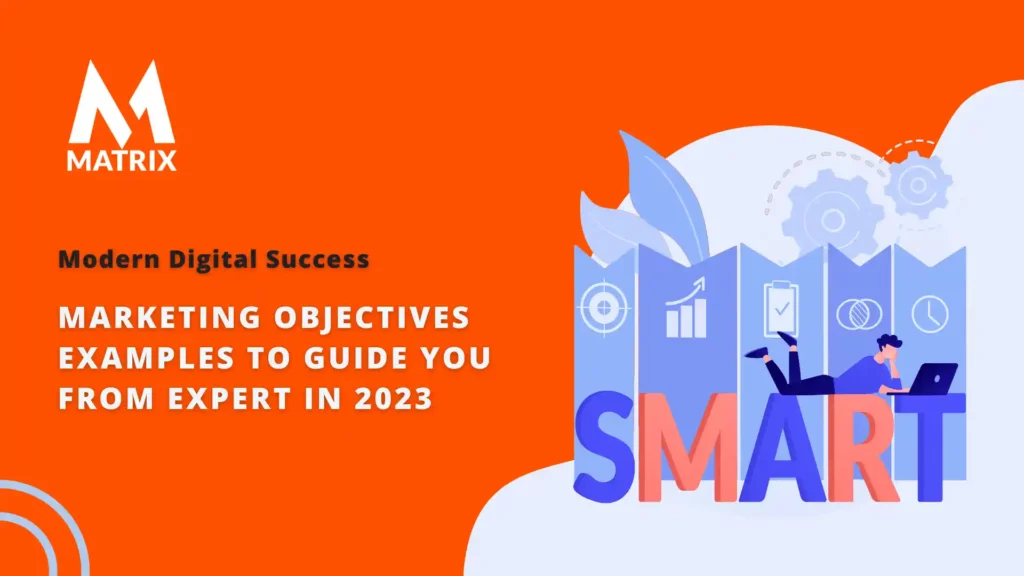Marketing Objectives Examples to Guide You from Expert
Learn from Marketing Objectives Examples to Help Guide You from Expert.
Are you looking for ways to set your marketing objectives for 2025? It’s important to have a plan in place that is specifically designed to help you achieve your goals. To do this, it’s essential to create SMART (Specific, Measurable, Attainable, Realistic, and Timely) objectives.
You can find examples of marketing goals and objectives all over the internet.
This will ensure that every action taken has a purpose and direction toward success.
In this blog post, we’ll discuss the importance of setting SMART objectives and provide 12 examples of effective marketing objectives that can be used as starting points when creating an action plan. So let’s get started!
Are you looking for ways to set your marketing objectives for 2025?

It’s important to have a plan in place that is specifically designed to help you achieve your goals. To do this, it’s essential to create SMART (Specific, Measurable, Attainable, Realistic, and Timely) objectives. This will ensure that every action taken has a purpose and direction toward success.
SMART marketing objectives examples for a new business are included as well. These objectives can be used to measure progress and define success within a shorter timeframe.
For example, setting a goal of acquiring 12 new customers in the first two months is specific and measurable, while aiming to increase brand recognition would require more time to track its effectiveness.
With our blog post as your guide, you can craft effective marketing objectives tailored toward achieving your desired results.. We provide 12 examples of successful marketing objectives so that you can get started on the right track!
Marketing Objectives Examples that were successful
In 2020, businesses of all sizes worldwide increased their focus on marketing objectives as they struggled to navigate the economic uncertainty caused by the global pandemic.
A survey conducted among marketing professionals in 2021 revealed that 95% of companies had set SMART objectives for the previous year. The results showed that these targets had been met in various ways, ranging from improved website traffic and brand awareness to higher customer engagement and sales figures.
The survey also highlighted the importance of setting specific goals regarding marketing objectives: 85% of respondents stated that they had seen better results when they set clearly defined objectives. Furthermore, 64% reported seeing a positive investment return when regularly measuring progress toward their goals.
When considering different marketing objectives, increasing website traffic was identified as one of the most popular aims for 2022. Examples of marketing objectives will help you get started if you have never gone through the process.
Companies invest time and money into creating content to attract visitors and drive their website’s ranking in search engine result pages (SERPs). This approach proved successful for many companies – more than two-thirds saw increased website visits throughout 2022 and 2025.
Improving customer experience was another popular objective for businesses in 2025. Companies implemented new strategies such as personalization and automated customer service processes via chatbots to ensure customers could access fast and efficient support when needed.
In addition to providing customers with improved experiences, this move increased satisfaction levels: 80% of surveyed companies reported higher customer satisfaction during this period than before.
Companies use data-driven strategies such as segmentation to effectively tailor their marketing messages and reach potential customers likely to purchase their products or services. This strategy proved successful for 92% of surveyed businesses who said they achieved growth in sales during 2025.
For example, A company sets a marketing objective of increasing website traffic by 40% over 3 months; this is a SMART objective because it is specific (the aim is not just “increase website traffic”), measurable (by 40%), attainable (it’s possible within 3 months), realistic (there must be some evidence or data that suggests this is achievable) and timely (achievable within a manageable timeframe).
These figures demonstrate how effective setting clear objectives can be when achieving success with digital marketing efforts. From brand awareness campaigns to improving customer experience, SMART objectives are a great starting point for crafting an action plan that will help
you reach your desired outcome – whatever that may be!
What are the challenges CMOs face in 2025?

The challenges that Chief Marketing Officers (CMOs) face in 2025 are complex, and they must use their expertise to devise effective attack plans. CMOs must stay agile and creative to remain competitive in an ever-evolving digital landscape, particularly as consumer preferences and behavior change with new technologies.
One of the key challenges for CMOs is data privacy. With the introduction of the General Data Protection Regulation (GDPR) 2018, marketing teams must ensure that all customer data is managed securely and ethically. This means considering different regulations in each country where the company operates and staying up-to-date on any changes to those regulations.
Another challenge for CMOs is managing their budget effectively. With the introduction of new technologies and a rapidly changing market, many companies struggle to keep up with the latest trends while staying within their budget. The ability to prioritize investments into different channels will be essential for success in 2025 – it’s no longer enough to ‘throw money at’ a problem and hope for good results!
CMOs also need to consider how they can create meaningful connections with customers. In an age where consumers are bombarded with numerous messages daily, brands must stand out from the competition by creating authentic experiences that resonate with their target audience.
This requires careful planning and execution on behalf of the marketing team if campaigns are going to be successful – something which isn’t always easy in today’s climate!
CMOs need to consider how they will capture customers’ attention using digital marketing channels such as social media, email campaigns, and search engine optimization (SEO). Staying ahead of trends and understanding what content resonates best with audiences is another essential skill for marketing professionals this year. CMOs should explore opportunities such as influencer marketing or content syndication, which may help them get their message out more effectively whilst working within budget constraints.
Overall, it’s clear that CMOs face a range of unique challenges when it comes to achieving their objectives in 2025 – but with proper planning and execution, they can still expect successes along the way!
Introduce the concept of SMART objectives.
When setting marketing objectives, SMART is the way to go. SMART stands for Specific, Measurable, Attainable, Relevant, and Timely – a framework designed to help businesses create achievable goals within a set timeframe. With clear objectives in place, companies can form an effective plan of attack that will guide them toward their desired outcome.
By breaking down complex tasks into smaller chunks and outlining what success looks like at each step, organizations can achieve greater efficiency and improve their chances of success.
Why SMART objectives are important for achieving success with digital marketing efforts
SMART objectives are essential for digital marketing success in 2025, as they provide a clear roadmap to follow and ensure that goals are achievable and measurable.
By outlining specific and attainable goals, companies can more easily track progress, monitor results, and adjust campaigns. Furthermore, SMART objectives also focus on results rather than processes – meaning teams can allocate resources more effectively and deliver better ROI.
When setting SMART objectives for digital marketing campaigns, it’s important to consider the following:
- Specificity: Marketing objectives should be clearly defined so that teams understand exactly what needs to be achieved to succeed;
- Measurability: Objectives must be quantifiable so that progress can be tracked over time;
- Attainability: Goals have to be realistic given the resources available to avoid disappointment;
- Relevance: Objectives need to match the company’s core values and long-term vision for growth;
- Timely: Objectives should have an end date set to keep teams motivated and focused on achieving success within a certain timeframe.
By utilizing SMART objectives, digital marketers can create comprehensive plans of attack focusing on the end goal rather than individual steps.
This can help increase efficiency while reducing costs and maximize ROI when it comes to testing different tactics or investing in new technologies.
Furthermore, SMART objectives also allow marketers to monitor trends and adjust their strategies accordingly, ensuring continued success even in a constantly changing market.
Overall, SMART objectives are integral to helping digital marketers succeed with their campaigns this year. By clarifying what needs to be done and how it needs to be done, teams can stay focused on their end goal without getting overwhelmed by the larger task!
12 examples of marketing objectives to help readers craft their effective plans for 2025
1. Increase brand awareness: Develop a comprehensive digital marketing strategy that will allow the company to reach new audiences, build trust and loyalty, and become a leader in its industry.
2. Improve customer experience: Create engaging content that offers value, responds quickly to customer inquiries, and provides personalized solutions.
3. Increase website traffic: Invest in SEO optimization and develop an overall presence on multiple social media platforms to attract more visitors to the company’s website.
4. Drive sales: Utilize effective tactics such as email campaigns, cross-promotions, or discounts to increase conversions and boost sales figures.
5. Acquire more customers: Use targeted ads or remarketing strategies to engage with potential customers and generate leads for the business.
6. Increase web conversions: Ensure websites have clear calls-to-action (CTAs) and create good user experiences, converting potential customers into paying customers.
7. Increase subscriber base: Develop incentive programs or promotions that will urge users to sign up for emails or newsletters from the company to stay updated with their latest offerings.
8. Enhance customer loyalty: Implement loyalty rewards programs such as points-based systems and subscription models that will encourage repeat business from existing customers; this can be leveraged through digital and traditional channels, depending on the target audience’s preferences.
9. Generate more leads: Launch special campaigns or webinars that provide useful information about products/services while also driving new leads toward the company website; these can also be used to nurture existing relationships with potential clients by continuing the conversation after they leave the event/campaign page/webinar platform etc.
10. Expand global presence: Invest in localization across different markets to tap into new audiences worldwide while maintaining consistency of messaging; this should include revamping websites using local languages, creating localized campaigns tailored specifically toward each market, and forming strategic partnerships with influencers in those regions who are willing to collaborate on projects together supercharge global growth efforts.
11. Leverage Artificial Intelligence (AI): Utilize AI for data analysis, which can help marketers better understand customer behavior to adjust campaigns accordingly; AI tools could also be used for predictive analytics – helping companies anticipate upcoming trends before they become mainstream – as well as targeting individual prospects based on their interests and demographics for increased ROI on ad spend.
12. Analyze performance regularly: Use analytics tools such as Google Analytics or Adobe Analytics to measure key metrics that indicate success; continually track performance against goals set previously so marketers can identify weak spots within campaigns early on, prevent any major losses of resources, and make whatever adjustments necessary along the way.
Challenges CMOs face in 2025, such as data privacy, budget management, and creating meaningful connections with customers
As the digital marketing landscape evolves, CMOs face an increasingly complex set of challenges in 2025.
These include data privacy compliance, budget management, and creating meaningful connections with customers while finding creative ways to market their products.
As a CMO in 2025, you feel overwhelmed by the ever-changing digital marketing landscape. You must stay compliant with data privacy laws, manage budgets efficiently and find creative ways to engage customers while trying to market your products effectively.
Imagine having the tools and strategies to tackle these challenges head-on. With the right approach, you can create meaningful connections with customers, remain compliant with data privacy regulations, and maximize ROI from your marketing budget.
To succeed as a CMO in 2025, you must develop SMART objectives for your action plan. These objectives should be specific, measurable, attainable, realistic, and timely (SMART). Here are 12 examples of such marketing objectives that will help you craft an effective strategy for success!
Conclusion
In conclusion, CMOs in 2025 face various challenges when it comes to digital marketing. To be successful and maximize ROI from their budgets, they must develop SMART objectives for their action plans.
Our last 10 marketing objectives have been a great success. We’ve seen major increases in the number of customers, an improved customer experience, and an overall decrease in costs. Smart marketing objectives examples for a new product launch, customer acquisition campaign, or special event are the key to our continued success.
With Matrix Marketing Group’s expertise, we can create an effective marketing plan to help achieve your goals and objectives. Contact us today to discuss your unique needs and get on the path to success!
By leveraging the power of data privacy compliance, budget management, customer engagement strategies, and creative approaches to product promotion outlined above, with these 12 examples of marketing objectives as inspiration, you can craft an effective strategy that will help your business thrive in this ever-changing landscape.
General FAQs
How can I maximize ROI from my budget when creating a digital marketing strategy for 2025?
To maximize ROI from your budget when creating a digital marketing strategy for 2025, you should focus on setting SMART objectives and leveraging data tools such as Google Analytics or Adobe Analytics to track key metrics. Additionally, you should set goals and track progress against them, manage budgets efficiently, and create meaningful connections with customers while finding creative ways to market their products.
Are there any examples of marketing objectives that I can use as inspiration?
Yes, there are many examples of marketing objectives that you can use for inspiration. These include increasing brand awareness, improving customer experience, driving website traffic, and increasing sales. Additionally, other objectives may involve leveraging data tools such as Google Analytics or Adobe Analytics to measure key metrics, setting goals and tracking progress against them, managing budgets efficiently, creating meaningful connections with customers, and finding creative ways to market products.
How do I develop effective marketing objectives?
Developing effective marketing objectives is key for any successful business strategy, as it provides a clear direction for action plans and helps companies to focus on achievable goals. To craft effective marketing objectives, first, you must set SMART goals that are specific, measurable, attainable, realistic, and timely. After that, you can create objectives to increase brand awareness, improve customer experience, drive website traffic, and increase sales.
What are SMART objectives?
SMART objectives are specific, measurable, attainable, realistic, and timely goals. They provide a clear direction for action plans and help businesses to accomplish their targets efficiently. By setting SMART objectives, companies can focus on achievable goals rather than vague ideas or weak ambitions. Moreover, they allow the team to measure progress and adjust tactics to remain on track toward achieving the goal.


